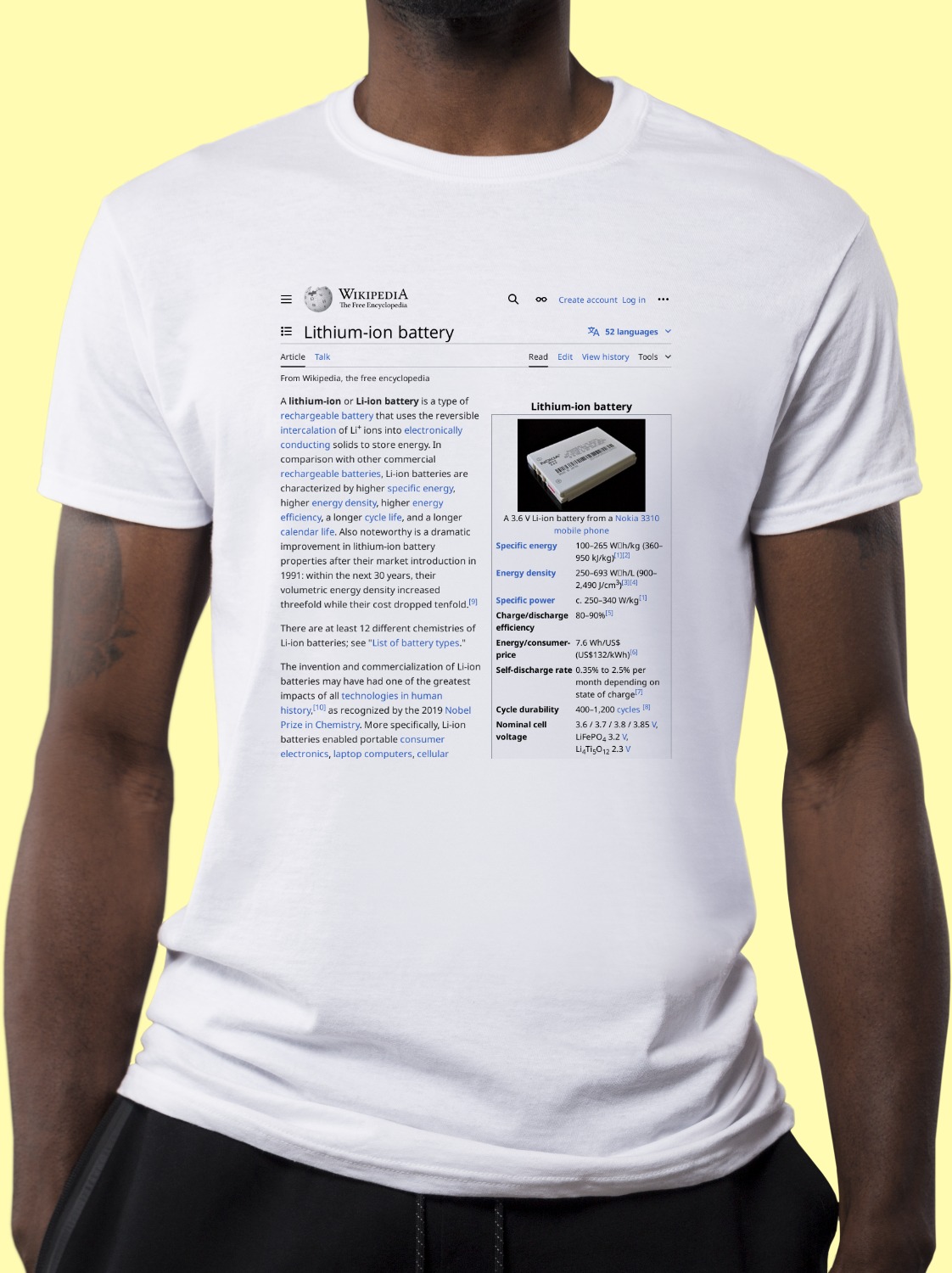
Lithium-ion battery Shirt
A classic cotton tee emblazoned with the Wikipedia article on Lithium-ion battery ↗.
cotton tee emblazoned with the Wikipedia article on Lithium-ion battery ↗.- Preshrunk jersey knit
- Seamless double-needle 2.2 cm collar
- Taped neck and shoulders
- Tear away label
- Double-needle sleeve and bottom hems
- Quarter-turned to eliminate centre crease
A lithium-ion or Li-ion battery is a type of rechargeable battery that uses the reversible intercalation of Li+ ions into electronically conducting solids to store energy. In comparison with other commercial rechargeable batteries, Li-ion batteries are characterized by higher specific energy, higher energy density, higher energy efficiency, a longer cycle life, and a longer calendar life. Also noteworthy is a dramatic improvement in lithium-ion battery properties after their market introduction in 1991; over the following 30 years, their volumetric energy density increased threefold while their cost dropped tenfold. In late 2024 global demand passed 1 terawatt-hour per year, while production capacity was more than twice that.
The invention and commercialization of Li-ion batteries has had a large impact on technology, as recognized by the 2019 Nobel Prize in Chemistry. Li-ion batteries enabled portable consumer electronics, laptop computers, cellular phones, and electric cars. Li-ion batteries also see significant use for grid-scale energy storage as well as military and aerospace applications.
M. Stanley Whittingham conceived intercalation electrodes in the 1970s and created the first rechargeable lithium-ion battery, based on a titanium disulfide cathode and a lithium-aluminium anode, although it suffered from safety problems and was never commercialized. John Goodenough expanded on this work in 1980 by using lithium cobalt oxide as a cathode. The first prototype of the modern Li-ion battery, which uses a carbonaceous anode rather than lithium metal, was developed by Akira Yoshino in 1985 and commercialized by a Sony and Asahi Kasei team led by Yoshio Nishi in 1991. Whittingham, Goodenough, and Yoshino were awarded the 2019 Nobel Prize in Chemistry for their contributions to the development of lithium-ion batteries.
Lithium-ion batteries can be a fire or explosion hazard as they contain flammable electrolytes. Progress has been made in the development and manufacturing of safer lithium-ion batteries. Lithium-ion solid-state batteries are being developed to eliminate the flammable electrolyte. Recycled batteries can create toxic waste, including from toxic metals, and are a fire risk. Both lithium and other minerals can have significant issues in mining, with lithium being water intensive in often arid regions and other minerals used in some Li-ion chemistries potentially being conflict minerals such as cobalt. Environmental issues have encouraged some researchers to improve mineral efficiency and find alternatives such as lithium iron phosphate lithium-ion chemistries or non-lithium-based battery chemistries such as sodium-ion and iron-air batteries.
"Li-ion battery" can be considered a generic term involving at least 12 different chemistries; see List of battery types. Lithium-ion cells can be manufactured to optimize energy density or power density. Handheld electronics mostly use lithium polymer batteries (with a polymer gel as an electrolyte), a lithium cobalt oxide (LiCoO
2) cathode material, and a graphite anode, which together offer high energy density. Lithium iron phosphate (LiFePO
4), lithium manganese oxide (LiMn
2O
4 spinel, or Li
2MnO
3-based lithium-rich layered materials, LMR-NMC), and lithium nickel manganese cobalt oxide (LiNiMnCoO
2 or NMC) may offer longer life and a higher discharge rate. NMC and its derivatives are widely used in the electrification of transport, one of the main technologies (combined with renewable energy) for reducing greenhouse gas emissions from vehicles.
About Wikishirt
Wikishirt is a retail experiment that lets you buy a shirt with any Wikipedia Article printed on it. There are over 5 million Wikipedia articles, so we have over 5 million shirts.Check out our homepage for random featured shirts and more!